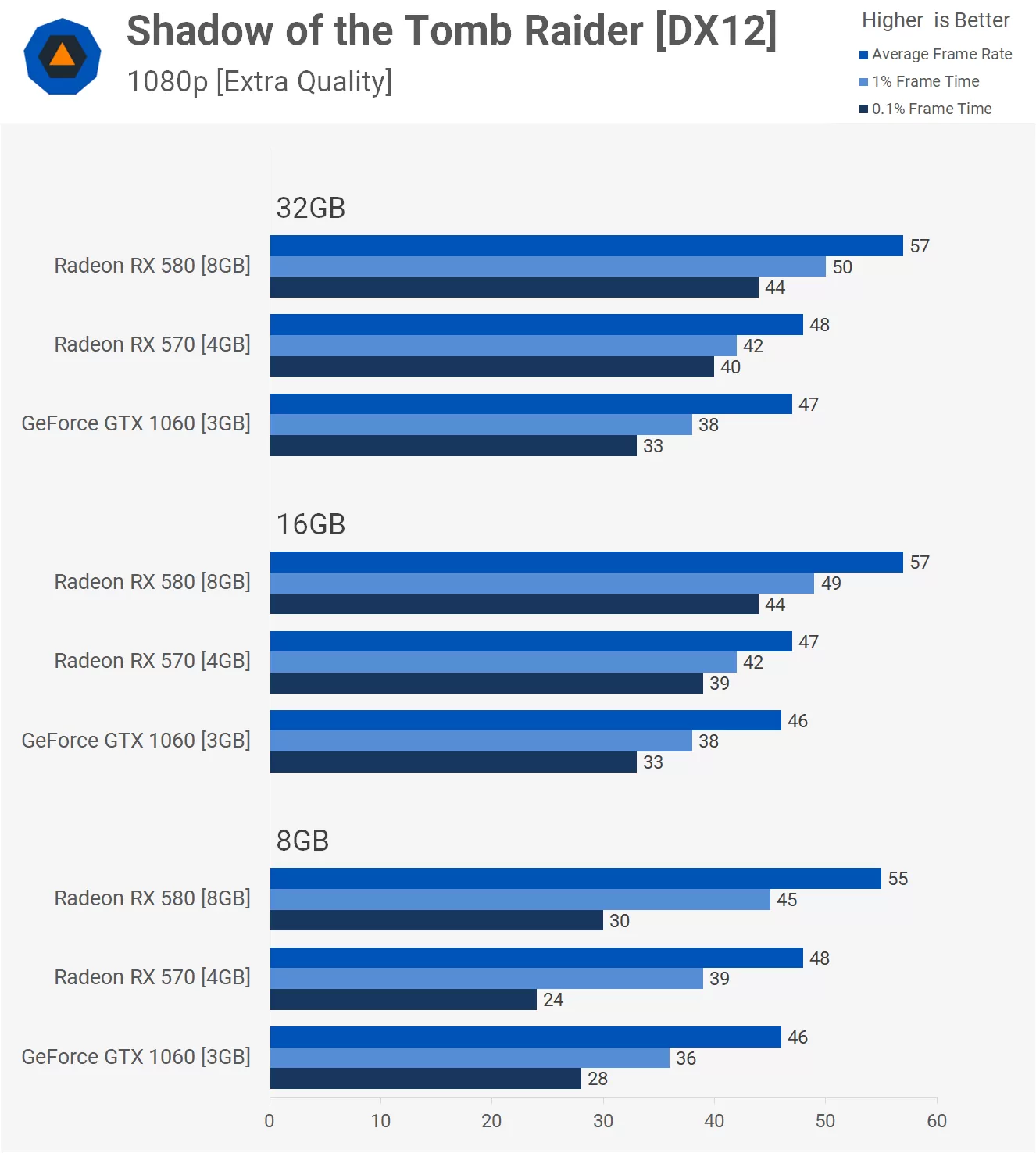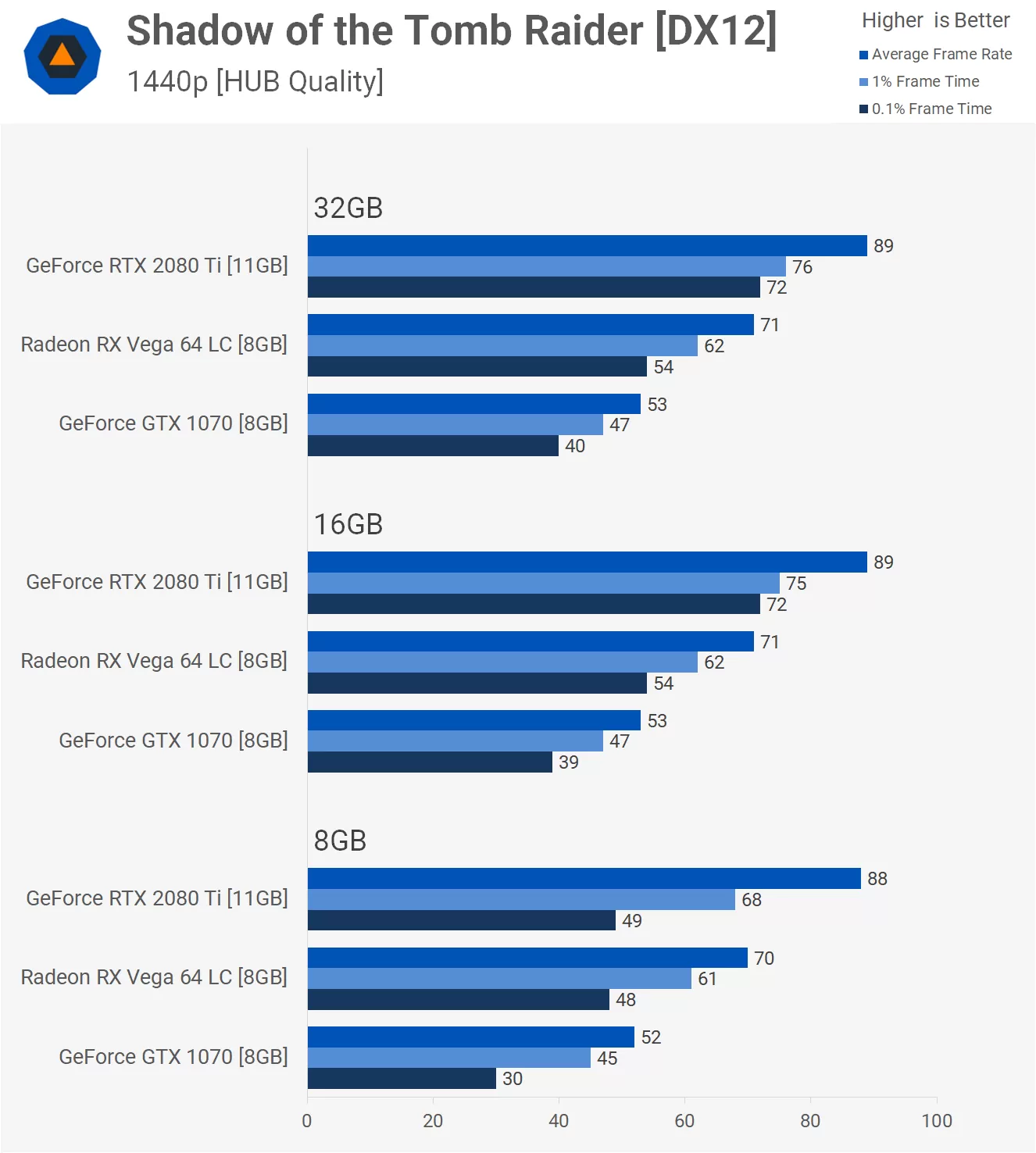Navigation
Install the app
How to install the app on iOS
Follow along with the video below to see how to install our site as a web app on your home screen.
Note: This feature may not be available in some browsers.
More options
You are using an out of date browser. It may not display this or other websites correctly.
You should upgrade or use an alternative browser.
You should upgrade or use an alternative browser.
Do you want 64GB of DDR5? Be prepared to spend two times more than DDR4 to go slower!
- Thread starter sblantipodi
- Start date
kirbyrj
Fully [H]
- Joined
- Feb 1, 2005
- Messages
- 30,693
OKC Yeakey Trentadue
[H]ard|Gawd
- Joined
- Nov 24, 2021
- Messages
- 1,205
There is definite advantages to 16GB over 8 GB in gaming, especially for cards that have relatively low vram for their performance level. 32 GB is a bit trickier. Tom's shows an improvement at 32 GB, but this is hard to determine if it is because it is running dual rank dual channel or from the extra ram.Outside some of the sims that can use a lot obviously (Citi builder have little limit with mods), there is some regular game that seem to do (even gain to go from 16 to 32 at certain stage of release pre-optimisation like early release of Cyberpunk and Flight Sim, on certain system it seem):
View attachment 424330
The 0.1 and 1% mostly can be Completetly different if you are on the limit on some system:


Very fast hard drive can make it less obvious
https://www.techspot.com/article/1971-more-ram-modules-better-for-gaming/
OKC Yeakey Trentadue
[H]ard|Gawd
- Joined
- Nov 24, 2021
- Messages
- 1,205
DDR5 is full of false advertisement, bad marketing and a lot of missunderstandings.
This is the reality of the current situation.
View attachment 423575
There is no single rank 32GB DDR5 modules currently.
This means that if you want 64GB of DDR5 memory you have two options.
Get a 2x32GB dual rank modules.
Get a 4x16GB single rank modules.
In every cases you base frequency drops to a crappy 4GHz.
I'm using 4x16GB of Dominator 5600MHz C36 and I'm not able to drive them at 4.8GHz even with 1.35V on the memory and 1.25V on the memory controller/SA.
I need to drive my 1000€ of RAM on my 1200€ of motherboard (Asus Z690 Maximus Extreme) at 4.4GHz.
DDR5 at 4.4GHz is slower than DDR4 at 3.6GHz.
This means that I spent two times more to go slower than cheap DDR4 modules.
Don't make my mistake!!!
Honestly, I wish they went tri channel ddr4 like they did with ddr3. 12GB would be solid for budget users, 24 GB would be great for the vast majority and 48 GB would be more than enough for power users. Beyond that, there is always HEDT.
Furthermore, trichannel ddr4 would easily outperform dual channel ddr5 until it further matured.
The problem with that is the extra bandwidth rarely if ever helps with most desktop applications or games. We saw this repeatedly with X58 and later quad channel HEDT systems where comparable CPU's were compared to their mainstream counterparts. Furthermore, the added trace paths increase motherboard cost and RAM upgrades are more expensive for the customer without any real benefit to it.Honestly, I wish they went tri channel ddr4 like they did with ddr3. 12GB would be solid for budget users, 24 GB would be great for the vast majority and 48 GB would be more than enough for power users. Beyond that, there is always HEDT.
Furthermore, trichannel ddr4 would easily outperform dual channel ddr5 until it further matured.
Red Falcon
[H]ard DCOTM December 2023
- Joined
- May 7, 2007
- Messages
- 12,444
Optimized Windows 7/10 + Fallout 4 at max settings and 2k resolution would easily use over 11GB RAM back in 2016.I am not aware of any regular gaming PC that it can make good use of 16GB of RAM.
Might want to get with the times.
OKC Yeakey Trentadue
[H]ard|Gawd
- Joined
- Nov 24, 2021
- Messages
- 1,205
Wouldn't it be less trace paths for mATX and above since you would have 3 instead of 4? You could still run 2 paths or less with itx and below albeit a small performance decrease. Either way you get the lower latency.The problem with that is the extra bandwidth rarely if ever helps with most desktop applications or games. We saw this repeatedly with X58 and later quad channel HEDT systems where comparable CPU's were compared to their mainstream counterparts. Furthermore, the added trace paths increase motherboard cost and RAM upgrades are more expensive for the customer without any real benefit to it.
Perhaps software has mature some since x58 to take advantage of at least the tri channel, though maybe still not the quad channel of HEDT.
Not really. Most consumer workloads show the same performance on either dual or quad channel, so triple would end up being in the middle of the same. I run HEDT for PCIE lanes and more cores, but the RAM part is mostly a shrug even for me - and I'm using ramdisks for various things.Wouldn't it be less trace paths for mATX and above since you would have 3 instead of 4? You could still run 2 paths or less with itx and below albeit a small performance decrease. Either way you get the lower latency.
Perhaps software has mature some since x58 to take advantage of at least the tri channel, though maybe still not the quad channel of HEDT.
Micro-ATX boards usually have four slots. Mini-ITX boards have two. You would have six slots on most motherboards if we were using triple channel memory. Also, four slots doesn't use as many trace paths as you might think given that most boards these days use a daisy chain toplogy. I'm not sure if that would be more or less than three slots in three separate channels.Wouldn't it be less trace paths for mATX and above since you would have 3 instead of 4? You could still run 2 paths or less with itx and below albeit a small performance decrease. Either way you get the lower latency.
Perhaps software has mature some since x58 to take advantage of at least the tri channel, though maybe still not the quad channel of HEDT.
Again, the testing was done time and time again and even modern quad-channel setups provide no benefit over dual-channel configurations in the same applications. It isn't a matter of software catching up as some applications just don't benefit from it because of how they work.
sblantipodi
2[H]4U
- Joined
- Aug 29, 2010
- Messages
- 3,765
at the end I was able to run 6000MHz no problem on my 2x16GB Samsung Corsair Dominator 5600MHz C36 using XMP and no other settings changed apart the ram frequency.
if I add two sticks more I goes down from 6GHz to 4.4GHz since I can't get 4.8GHz stable with 4 sticks.
How this can be possible?
From 6GHz stable with 1.25V RAM and 1.25SA to 4.4GHz?
don't buy 4 slots mobos, they are meaningless.
if I add two sticks more I goes down from 6GHz to 4.4GHz since I can't get 4.8GHz stable with 4 sticks.
How this can be possible?
From 6GHz stable with 1.25V RAM and 1.25SA to 4.4GHz?
don't buy 4 slots mobos, they are meaningless.
Depends on what you're trying to accomplish. If the last 1-2 fps doesn't matter, RAM counts might. I wouldn't buy a board with less than 4 slots (my one micro-server aside); can't put enough RAM in them for the future.at the end I was able to run 6000MHz no problem on my 2x16GB Samsung Corsair Dominator 5600MHz C36 using XMP and no other settings changed apart the ram frequency.
if I add two sticks more I goes down from 6GHz to 4.4GHz since I can't get 4.8GHz stable with 4 sticks.
How this can be possible?
From 6GHz stable with 1.25V RAM and 1.25SA to 4.4GHz?
don't buy 4 slots mobos, they are meaningless.
NattyKathy
[H]ard|Gawd
- Joined
- Jan 20, 2019
- Messages
- 1,478
4 slots is fine, good even, for upgradeability or taking advantage of weird DRAM pricing steps.
Look, it's unfortunate that ppl are having issues with their new systems. That's legit really frustrating and potentially disruptive. At the same time we've gotta be realistic about it- Alder Lake + Z690 + DDR5 are all first-gen of their kind and were all released just 9 weeks ago. The first DDR4 droppedsix over 7 years ago, so of course first-gen DDR5 will unfortunately not match up with last-gen DDR4 mem & platforms compatibility and tuning potential.
It's possible BIOS updates and newer memory modules will improve the situation somewhat next year for even current AL CPUs & mobos much like what happened with Zen 1.
Look, it's unfortunate that ppl are having issues with their new systems. That's legit really frustrating and potentially disruptive. At the same time we've gotta be realistic about it- Alder Lake + Z690 + DDR5 are all first-gen of their kind and were all released just 9 weeks ago. The first DDR4 dropped
It's possible BIOS updates and newer memory modules will improve the situation somewhat next year for even current AL CPUs & mobos much like what happened with Zen 1.
Last edited:
JSHamlet234
Gawd
- Joined
- Apr 9, 2021
- Messages
- 943
at the end I was able to run 6000MHz no problem on my 2x16GB Samsung Corsair Dominator 5600MHz C36 using XMP and no other settings changed apart the ram frequency.
if I add two sticks more I goes down from 6GHz to 4.4GHz since I can't get 4.8GHz stable with 4 sticks.
How this can be possible?
From 6GHz stable with 1.25V RAM and 1.25SA to 4.4GHz?
don't buy 4 slots mobos, they are meaningless.
So you had to drop from 6000 to 4400 in order to go from 2 sticks to 4? Wow. I think that's more of a hit than anyone would have anticipated. Good to know. I wonder if there are voltages that can be tweaked to get higher than 4400 with 4 sticks or if you really just hit a wall?
Sounds like something is going on with that specific combination of hardware / firmware. However, while I have a couple of DDR5 motherboards and a couple 12900K's, I have but one set of DDR5 RAM for now. I seriously doubt you would have to drop below 4800MHz for four modules but that's speculative on my part.So you had to drop from 6000 to 4400 in order to go from 2 sticks to 4? Wow. I think that's more of a hit than anyone would have anticipated. Good to know. I wonder if there are voltages that can be tweaked to get higher than 4400 with 4 sticks or if you really just hit a wall?
sblantipodi
2[H]4U
- Joined
- Aug 29, 2010
- Messages
- 3,765
So you had to drop from 6000 to 4400 in order to go from 2 sticks to 4? Wow. I think that's more of a hit than anyone would have anticipated. Good to know. I wonder if there are voltages that can be tweaked to get higher than 4400 with 4 sticks or if you really just hit a wall?
Correct, from 2 sticks at 6GHz, I need to lower to 4.4GHz to get 4 sticks stable.
I have tried all the suggested voltages for big OC and 4.8GHz became a little bit more stable but it isn't 100% stable so I reverted back to 4.4GHz.
GoldenTiger
Fully [H]
- Joined
- Dec 2, 2004
- Messages
- 29,646
So, how'd you get the ddr5? Finally pay a scalper?Correct, from 2 sticks at 6GHz, I need to lower to 4.4GHz to get 4 sticks stable.
I have tried all the suggested voltages for big OC and 4.8GHz became a little bit more stable but it isn't 100% stable so I reverted back to 4.4GHz.
https://www.anandtech.com/show/16959/intel-innovation-alder-lake-november-4th/4Sounds like something is going on with that specific combination of hardware / firmware. However, while I have a couple of DDR5 motherboards and a couple 12900K's, I have but one set of DDR5 RAM for now. I seriously doubt you would have to drop below 4800MHz for four modules but that's speculative on my part.
So officially Intel doesn't support it at higher speeds.
Doesn't mean a motherboard cannot go higher with better configuration through BIOS, but it isn't supported at higher rates and if a motherboard doesn't go higher, it is working as intended.
Yeah, I hadn't looked into it all that deeply at the time I posted that initially. But looking at the tables, this makes sense now. I'd also point out that this is early hardware and that the IMC on Alder Lake-S are designed to support both DDR4 and DDR5. Even though you might be able to go higher, I wouldn't expect it on this early hardware.https://www.anandtech.com/show/16959/intel-innovation-alder-lake-november-4th/4
So officially Intel doesn't support it at higher speeds.
Doesn't mean a motherboard cannot go higher with better configuration through BIOS, but it isn't supported at higher rates and if a motherboard doesn't go higher, it is working as intended.
It's likely that DDR5 4000MHz is all the OP is going to get if he intends to use four modules. The other problem is that with DDR5 availability being so bad right now, it's not like buying a different kit of DDR4 if a given board doesn't like it. It's cost me $135 sometimes to do that and I've either dropped the memory that didn't work into something else or sold it / returned it with no issue. With DDR5, you aren't going to be able to do that. Sure, you can return if but you won't necessarily be able to replace it with another brand/kit very easily.
![[H]ard|Forum](/styles/hardforum/xenforo/logo_dark.png)
